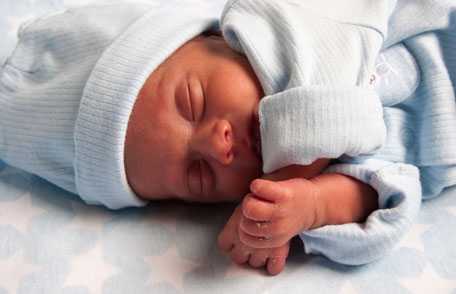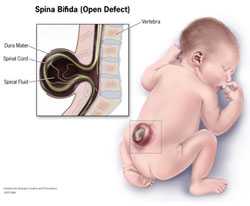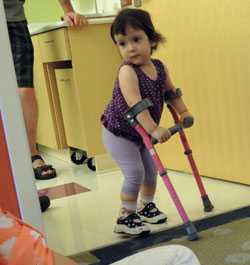Using Data to Help Babies Born with Spina Bifida

Learn how babies born with spina bifida are being protected.
About 3 in 10,000 babies are born each year with spina bifida, a serious birth defect of the spine. Complications from this condition can lead to severe kidney problems. As of mid-2017, more than 170 babies born with spina bifida have been enrolled in a new treatment plan designed to protect their kidneys.
CDC scientists and healthcare professionals who treat children with spina bifida designed the treatment plan. This is the first time a treatment plan with tests and clinical monitoring is being scientifically tested to determine which steps work best to protect the kidneys of babies born with spina bifida.
CDC research suggests that people with spina bifida develop kidney failure (their kidneys stop working) at a much younger age than people without spina bifida.1 This research, and the experience of doctors who specialize in the treatment of spina bifida, indicated a need to know how and when to intervene to protect babies’ kidneys.
How Spina Bifida Affects the Kidneys
- About 3 in 10,000 babies are born each year with spina bifida.2, 3
- Spina bifida is a neural tube defect, which results in damage to the nerves inside the spinal cord.
- In people with severe spina bifida, this nerve damage means that nerve signals from the brain do not get to the bladder for it to function correctly.
- When the bladder doesn’t work properly, the kidneys can be harmed because urine backs up into the kidneys.

Development of the treatment plan began in 2012. In 2014, CDC funded nine spina bifida specialty clinics from the National Spina Bifida Patient Registry to begin enrolling babies 0-3 months of age. Formally called the Urologic and Renal Protocol for the Newborn and Young Child, the treatment plan contains a detailed medical decision tree. A decision tree is a multilevel drawing that shows the choices available at each point in managing a patient’s medical care.
This decision tree outlines the tests and scans that are performed at specific intervals in the treatment plan. They are designed to
- track and manage each baby’s bladder function,
- identify infections in the bladder and kidneys (urinary tract),
- monitor kidney function,
- detect kidney scarring, and
- determine when babies with kidney problems should receive medications.
This unique treatment plan is designed to allow healthcare professionals at spina bifida clinics to make changes to the series of tests and scans as appropriate for each patient. Details on these changes and the data from the tests and scans are collected at each clinic.
These data are analyzed and will determine a new “best practice” standard of care for babies born with spina bifida. This standard of care will then be published and shared with spina bifida specialty clinics throughout the United States via CDC’s partnership with the Spina Bifida Association.
The treatment plan methodology was published online during the summer of 2016. Proposed research topics from the treatment plan data include management of urinary tract infections, the ideal number of ultrasounds needed in the first year of life, and a description of this group of these babies in their first year of life.

CDC research suggests that people with spina bifida developed kidney failure at a much younger age than people without spina bifida.1
What You Can Do
Parents: If you’re a parent of a baby or young child with spina bifida or know someone who is, share CDC’s UTI fact sheets:
- What parents should know: Urinary tract infections in young children with spina bifida (English version) [93.6 KB]
- What parents should know: Urinary tract infections in young children with spina bifida (Spanish version) [84.8 KB]
Healthcare professionals: If you treat babies and young children with spina bifida, consider integrating components of the urological protocol into your practice.
References
- Ouyang L, Bolen J, Valdez R, Joseph D, Baum MA, Thibadeau J. Characteristics and survival of patients with end stage renal disease and spina bifida in the United States Renal Data System . J Urol. 2015 Feb;193(2):558-64.
- Lloyd JC, Weiner JS, Gargollo PC, Inman BA, Ross SS, Routh JC. Contemporary epidemiological trends in complex congenital genitourinary anomalies . J Urol 2013 Oct;190(4 Suppl):1590-5.
- Parker SE, Mai CT, Canfield MA, Rickard R, Wang Y, Meyer RE, Anderson P, Mason CA, Collins JS, Kirby RS, Correa A; National Birth Defects Prevention Network. Updated national birth prevalence estimates for selected birth defects in the United States, 2004-2006 . Birth Defects Res A Clin Mol Teratol, 2010 Dec;88(12):1008-16.
- Page last reviewed: September 19, 2017
- Page last updated: September 19, 2017
- Content source:
- National Center on Birth Defects and Developmental Disabilities
- Page maintained by: Office of the Associate Director for Communication, Digital Media Branch, Division of Public Affairs




 ShareCompartir
ShareCompartir